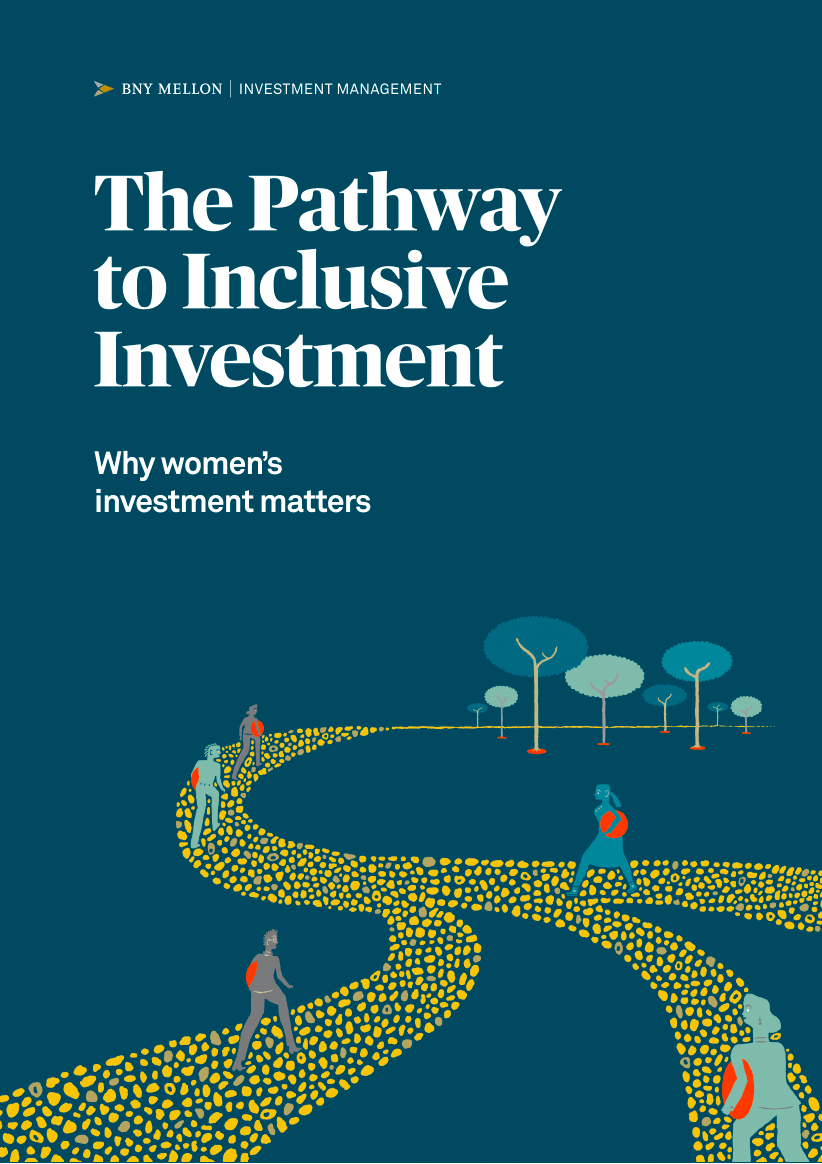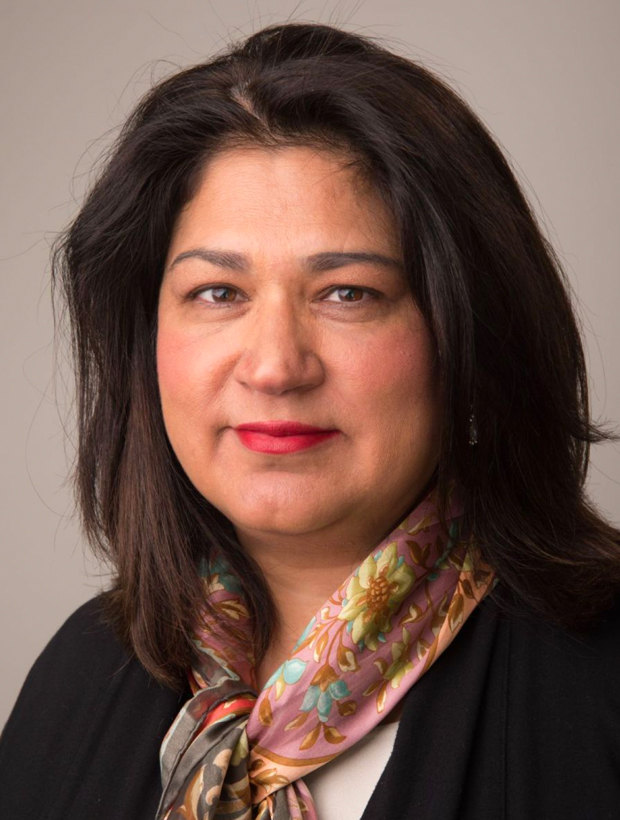The Pathway to Inclusive Investment
Why women’s investment matters
We set out to explore some of the key drivers behind the persistent gender-investment gap from the perspective of those who currently invest, those who don’t, and the investment industry itself.
We interviewed
8000
women and men
across
16
markets1
and
100
asset management firms
managing nearly
$60
trillion
in assets2
This report explores the gender-investment gap and the benefits of more women investing. Despite this issue being in the spotlight for decades, women are still less likely to invest, compounding any financial disadvantages and limiting women’s collective influence on corporate behavior and the world.

The value of investments can fall. Investors may not get back the amount invested.
If women invested at the same rate as men, there would be at least an extra:
$3.22 trillion3
of assets under management from private individuals today
$1.87 trillion4
of additional capital into Responsible Investment


We found that if women invested at the same rate as men, there would be at least an extra $3.22 trillion of assets under management from private individuals today. Perhaps more important, our research also reveals that women are more likely to make investments that have positive social and environmental impacts, meaning that there would be an influx of $1.87 trillion of additional capital into Responsible Investment if women invested at the same rate as men.
Our study found Three key barriers to higher levels of female participation in investing:
Crisis
Globally, just 28% of women feel
confident about investing some
of their money.
Hurdle
On average and globally, women think that they need $4,092 of disposable income each month – $50,000 per year – before [they can begin] investing some of their money.
Almost half of women (45%) say that investing money in the stock market – either directly or in a fund – is too risky for them. Only 9% of women report that they have a high or very high level of risk tolerance when it comes to investing; 49% have a moderate risk tolerance; and 42% have low risk tolerance.
Women tend to feel less confident about investing than savings, property or pensions. In our report, we explore the reasons why more women aren’t investing and how the investment industry can evolve to support more inclusive investment.
We want to champion the power of investing – and the power of female investment – in order to demonstrate that inclusivity and diversity matters, and that the time to act is now.
Hanneke Smits
CEO
BNY Mellon Investment Management

In order to understand why women don’t invest at the same rate as men, and to explore what we in the industry can do to raise levels of female participation, we interviewed 8,000 men and women worldwide.
Our research revealed that the investment industry must tackle three key investment barriers to encourage more women to invest:

The investment industry is failing to reach, appeal to, and engage women to the same degree as men. Globally, as few as one in 10 women feel they fully understand investing, and less than a third of women (28%) feel confident about investing some of their money.
With such a low percentage of women comfortable investing some of their money, the need for better communication and engagement is clear. Across key aspects of financial decision-making, investment is the area where fewest women feel confident, compared to making decisions around savings, property and pensions.
On average and globally, women believe they need $4,092 of disposable income each month—almost $50,000 per year—before they would consider investing any of it. In the US, for example, on average women believe that they need over $6,000 of monthly disposable income—just over $72,000 per year—before they can start investing.
Clearly this is unrealistic, especially given the fact that over a quarter of women (27%) describe their financial health as poor or very poor. For the investment industry, overcoming this misconception and explaining that only a small amount of money is needed to start investing should be a key focus.
In the UK, the annual tax-free contribution limit for Individual Savings Accounts (ISAs)—which can be invested in stocks and shares—is £20,0006 [$27,550]. But rather than understanding this as a limit, many people seemed to be under the impression that this was a minimum or target amount.
Gemma Godfrey
UK finance expert,
non-executive director
and entrepreneur

Investing does involve risk, of course, but the perception that investing always has to be incredibly high-stakes is not the case. And leaving your money in a savings account isn’t completely risk-free either. During a time of low-interest rates, money in a savings account is losing purchasing power* over the long term as it is lagging behind inflation.
Iona Bain
UK finance expert,
journalist, podcaster
and author
Purchasing power is the quantity of goods or services that a dollar or another unit of currency can buy. Inflation means that purchasing power is reduced, so that you can buy fewer products with the same amount of money. For example, $5 may have bought you 10 cups of coffee 20 years ago but may only buy you two cups of coffee today.
What then could encourage more women to invest? Our study shows that women across the world are motivated by the impact that their investments could have. More than half of women (55%), for example, would invest (or invest more) if the impact of their investment aligned with their personal values, and 53% would invest (or invest more) if the investment fund had a clear goal or purpose for good. Two-thirds of women who currently invest (66%) try to invest in companies they like and that support their personal values.
This drive to align investments with values seems to be stronger among those with children: three-quarters of parents – both women and men – who currently invest say that they prefer to invest in companies that support their personal values, compared with 59% of adults who do not have children.
Naturally, women want to see returns on their investments, but they also want to see the impact of their money. Investing for the future—whether it is their own financial security, or for the future of the planet—goes hand in hand with female empowerment.
Holly Mackay
UK finance expert,
founder and managing
director of Boring Money

Looking beyond return
Responsible Investment (RI) generally means investing for a better future; a more sustainable, diverse, and equitable future. RI covers a spectrum of investing styles, including exclusionary screening, Environmental, Social, and Governance (ESG) integration, sustainable investing and impact investing. ESG integration is the systematic and explicit incorporation of ESG factors into financial analysis and investment decisions to better manage risks and return objectives. Impact investing goes a step beyond ESG investing. It is the practice of investing with the dual objective of generating a positive, measurable and intended social or environmental impact, as well as a financial return.
Measuring the impact of investments can be difficult, and there is no single way of doing it, although there are many different approaches to responsible investing and frameworks, ranging from simply excluding investments that are harmful to society or the environment to actively selecting investments for the specific good that they do.
Interest in impact investing has been growing rapidly in recent years. According to the Global Impact Investing Network (GIIN), this particular market is now worth more than $700 billion8.
Younger women strive to combine purpose with profit
When it comes to combining purpose with profit, younger women are leading the way. Of those women who currently invest, 71% of women under 30 and 70% of women in their 30s and 40s prefer to invest in companies that support their personal values, compared with 53% of those over 50. Almost seven in 10 women under 30 who currently invest (69%) and 61% of those in their 30s and 40s say they select their current investments for their impact on social or environmental issues, compared with just 35% of women over 50.
Young women are seeing their money as a powerful force for good. There is evidence that young investors are becoming more confident about the stock market, getting to grips with the jargon and understanding how their money can grow while also having a positive impact on the world around them.
Iona Bain
UK financial expert,
journalist, podcaster
and author
The profile of those who invest is changing, and with it there is a shift in focus and values. Our data shows that older men—traditionally the “typical” investors targeted by the investment industry—are less focused on investing to have a positive impact and aligning their investments with their values. While 69% of young women (aged 18–30) who currently invest select their investments based on their impact, this is true of only a third (33%) of older men (aged over 50). And more than seven in 10 women under 30 (71%) prefer to invest in companies that support their personal values, compared with 54% of men over 50.
Investment values: younger
women vs. older men
it is important to me to choose investments that...
Making investing more accessible to women isn’t just about ensuring they have the right technology, but also inclusively equipping everyone with the knowledge, skills, and fostering the motivation to engage with investing. This requires a significant cultural shift within the industry—not only in the way that products are developed and marketed but also in the diversity of the investment industry itself.
We asked asset managers – representing nearly $60 trillion of assets under management – for their insights on the key challenges for gender-inclusive investment and for their thoughts on how the industry can change to encourage more women to invest. Their answers reveal the extent to which the investment industry is currently oriented toward male customers and help identify ways in which financial products and messaging could be reshaped to attract and engage more women.
Iona Bain
UK financial expert,
journalist, podcaster
and author
An industry with
men in mind
According to our study currently, nearly nine in 10 asset managers (86%) admit that their default investment customer is a man, and three-quarters of asset managers (73%) state that their organization’s investment products are primarily aimed at men, suggesting that they focus on the benefits and features that generally appeal more to men than women.
As a result, potential female investors are met with language, imagery and messaging targeted mainly at a male customer. This often includes the use of high-risk metaphors, such as those used in extreme sports, and the concept of high performance and achievement as a shorthand for investment success.

The idea of performance and wealth-building have become conflated in a way that isn’t necessarily healthy. Investing has become much more about performance, gamification, success or achievements, and less about building wealth over the long term.
Stefanie O'Connell
US millennial money
expert and author of The
Broke and Beautiful Life
There also is a tendency to use financial jargon and overcomplicated investment language in order to foster a sense that the investment customer is part of an exclusive club. This kind of marketing is actively off-putting to women: almost a third (31%) of female consumers said that overly complicated language [which can be unclear or confusing] dissuades them from investing or investing more than they currently do.
The language is quite technical and jargony—it’s that risk concept—the very word ‘risk’ is wrong—it isn’t risk, it’s uncertainty. Risk is doing something silly. That will put women off whatever age they are.
Holly Mackay
UK finance expert,
founder and managing
director of Boring Money
The answer to engaging women in investment isn’t found in outdated gimmicks and doesn’t require, for example, the increased use of the color pink. Rather, it’s about forming a connection by understanding what motivates women to invest and how they like to be communicated with.
If the industry can re-think the language around investing, there’s a significant opportunity to affect how much women invest: 37% of women said that if investment language were easier to understand, it would influence them to invest, or to invest more than they currently do. However, the key takeaway is that the language which describes financial products should not only be simpler, and avoid jargon, but also be more clearly aligned to women’s long-term goals and values.
As increasing health standards mean that today’s women need to plan for what might be a 100-year lifespan, women are motivated to invest by thinking of their long-term financial prosperity, independence, and the impact their investments can have. Products packaged to meet these needs and address these interests, clearly communicated in straightforward language, should go a long way to increasing women’s investment.

There’s an opportunity to engage women in a way that doesn’t tell them what they need to do differently. A lot of the messaging to women has been ‘you need to do this’, and that isn’t a productive way to drive behavior change – not least of all because the reasons women aren’t engaging are myriad, and this approach ignores all of them.
Stefanie O’Connell
US millennial money
expert and author
Building an inclusive
investment industry
A key step in fostering inclusive investment is creating a more diverse and inclusive investment industry. While some progress has been made, asset management continues to be a male-dominated industry, with significantly fewer female fund managers and investment analysts. Half of the asset managers participating in our study told us that just 10% or less of their organization’s fund managers and investment analysts are women. This may be contributing to the industry’s challenges in understanding and engaging female customers and, in turn, affecting women’s confidence in trusting an industry with their money when the women are apparently missing.
The benefits of attracting more female talent into the industry range from greater product innovation to encouraging more women to invest. Nearly three-quarters (73%) of asset managers believe the investment industry would be able to attract more women to invest if the industry had more female fund managers.
The biggest impact may be on younger age groups in the early stages of their investment journey. Three in 10 (29%) women under the age of 30 who already invest said that having a female financial advisor would influence them to invest more than they currently do, compared with 16% of those over 50 who already invest—perhaps because those over 50 have had time to resign themselves to the male-oriented nature of the industry.
In addition, fostering a more diverse talent pipeline for the industry will need to start early, making diverse role models visible to children and students, in their formative years. It could be that a concerted focus on inclusive investment could close the gender-investment gap and attract more women into the investment profession.

If we have women in key positions across these organizations, then the culture and the language that forms the industry will be different, and much more aligned to a female demographic. That would solve many of the issues that discourage women from investing.
Stefanie O’Connell
US millennial money
expert and author
A better balance of genders in the industry would encourage a more diverse range of people to invest and increase innovation and accessibility. We also need other women who invest or who work in investment to talk about their journey and how they started. It’s about social role models and awareness, non-conventional investment products, and lowering barriers to entry for everyone.
Cheryl Chong
Asia-Pacific finance
expert, co-founder of The
Social Co. and non-profit
adviser
We must seize the opportunity to attract more women to work in the industry and retain and develop the women already in the profession. Encouragingly, there are signs that women may be becoming more interested in a career in investing: although 72% of women over the age of 50 say they “would not and have never” considered a career in investing, this was true of only 47% of mid-career women and 45% of young women.
What Women Want:
Investing in Independence
Women value responsible investing and investments aligned with their personal values. They are also motivated to invest by a range of other factors, with financial independence topping the list. The investment industry, therefore, has a key opportunity to appeal to women by focusing on messaging around financial independence.
Almost two-thirds of women (63%) believe that it’s important that more women invest to provide for themselves in retirement, and six in 10 women believe that it is important that more women invest in order to give themselves greater financial independence. This rises to eight in 10 women in India (80%) and the US (79%). Historically, the industry marketed wealth products to women based on financial provision for their families; today, however, we find that investing in independence is more important than financing dependents. Motivators around retirement and independence are rated even more highly than growing a financial legacy for their family, for example (cited as important by 57% of women).
We believe it is up to us – the investment industry – to lead the change, by educating, inspiring, and including more women in all that we do. The traditional stereotype of the person who is interested in investing – the wealthy older man – is outdated and needs to be dismissed. Young women are interested in investing too, but they need to be empowered to do so. The face of investment is changing – and the industry needs to evolve too.
Empowering women to invest can come about by bringing the world of investment to them – by providing the knowledge and skills they need and realigning the messaging to promote conversations both inside and outside of the industry that speak to their motivations, be they financial, societal, or both.
Responsible investing allows women to champion causes they believe in effectively by using their money to directly help reach social and environmental goals. A greater focus on this type of messaging and on the wider benefits of investing can help to attract more women.
Greater diversity within the industry should also help to achieve higher levels of female participation and ultimately investment; but in order for a meaningful industry shift to take place, both women and men will need to help drive change.
If we all work together, we can achieve the goal of making investment more inclusive, for the benefit of all.
BNY Mellon Investment Management:
Actions speak louder than words
As part of a company that touches every part of the investment cycle – we believe we are in a strong position to make a difference. We can effect change at the grassroots through early engagement about money via our partnership with international group, Inspiring Girls. We can examine how to inspire the c20,000 women in our own organization to participate and invest more. We will review our approach and how we can engage with women better and work with intermediaries and the wider industry to make a difference and set clear targets for progress.
#AllStreet
Download
the report
Download

Credits
BNY Mellon Investment Management: The Pathway to Inclusive Investment is based on in-depth research commissioned by BNY Mellon Investment Management and designed by BNY Mellon Investment Management and Man Bites Dog. The research was also conducted by Man Bites Dog and Coleman Parkes. Cerulli supported the research by providing retail investment market data.
Inspiring Girls International
Inspiring Girls International is a charity, founded by Miriam Gonzalez Durantez, dedicated to raising the aspirations of young girls around the world by connecting them with amazing female role
models. We introduce young women to the full variety of careers and options in life and inspire them to aim high!
Expert Advisory Panel
The Expert Advisory Panel provided their perspectives on the research and their ideas on making investment more gender inclusive. Views of the Expert Advisory Panel are their own views.
Man Bites Dog
Man Bites Dog is an award-winning global thought leadership consultancy based in the UK, specializing in compelling content, campaigns and communications to tell their clients’ stories.
Coleman Parkes
Is a global B2B research specialist with first-rate experience across all verticals and markets. Coleman Parkes Research complies with the rules and regulations set by the MRS Code of Conduct
(2010) which is based upon the ESOMAR principles.
Cerulli Associates
For nearly 30 years, Cerulli has been at the forefront of the financial services industry, delivering ground-breaking global market research through the use of data.
Glossary – key terms
Saving: Saving generally involves putting your money into cash products, such as a savings account in a bank. Compared to investing, saving typically results in a lower return, but it involves historically much less risk (i.e., the chance that you will lose your money is very small).
Investing: Investing involves selecting particular assets with the goal that there may be a higher return. It is also about putting money away for the future, for long-term growth potential (i.e., your money increasing in value) in exchange for taking on more risk (i.e., the chance of losing your money is higher). Money is usually invested in stocks, funds, or bonds, where you could get back more or less than you originally put in.
Impact Investing: Impact investing is an investment strategy that aims to generate specific beneficial social or environmental effects in addition to potential financial gains. Impact investments may take the form of numerous asset classes and may result in many specific outcomes. The point of impact investing is to use money and investment capital for positive social results.
Active Ownership: is the use of the rights and position of ownership to influence the activities or behavior of investee companies.
Inflation: Inflation is the decline of purchasing power of a given currency over time. A quantitative estimate of the rate at which the decline in purchasing power occurs can be reflected in the increase of an average price level of a basket of selected goods and services in an economy over some period of time. The rise in the general level of prices, often expressed as a percentage, means that a unit of currency effectively buys less than it did in prior periods.
ESG (Environmental, Social and Governance) Criteria: A set of standards for a company’s operations that socially conscious investors use to screen potential investments.
References
- The 16 markets included in the study were: Australia, Brazil, Canada, China, France, Germany, Hong Kong, India, Italy, Japan, Nordics (Denmark, Finland, Norway, and Sweden), Singapore, Spain, Switzerland, the UK, and the USA.
- As at Q2 2021. All dollar currencies in report are US$
- This calculation was made using the data from the research on the average volumes of investments held by men and women to find the difference. We then used data from Cerulli to calculate the size of the retail investment market in each of the geographies within the study and applied the difference between male and female investment volumes to that number to show how much more investment would be available if female investment volumes matched male. This assumes the numbers of male and female investors are the same. As there are typically more male investors than female, the amount to be gained could be assumed to be even higher than the one shown, i.e., at least $3.22 trillion
- Our research also provided data on the share of investments made by men and women that are responsible i.e. investments that are qualified according to either their positive impact on society and the planet or at least their absence of a negative impact. The average share of female investments that are responsible was then applied to the overall uptick in investment volumes to reveal the percentage of those investments that can be expected to be responsible.
- Pound to dollar conversion accurate as of October 25, 2021
- Accurate as of the financial year 2021-2022
-
DQYDJ S&P 500 Periodic Reinvestment Calculator https://dqydj.com/sp-500-periodic-reinvestment[1]calculator-dividend
As of June 2021 - As at 11 June 2020
Contact Us
Get in TouchAbout the Study
Throughout 2021, BNY Mellon Investment Management commissioned one of the largest ever global independent consumer studies examining investment attitudes and behaviors. The research was conducted by Coleman Parkes Research and included 8,000 respondents across 16 markets - comprising consumers who already invest as part of their future financial planning, and those who currently do not invest. To provide an industry perspective, 100 global asset managers representing asset management firms with nearly $60 trillion (as at Q2 2021) of combined assets under management were also interviewed. To complement the global opinion research, the research included a series of in-depth discussions with an international advisory panel who provided their perspectives on the research and their ideas on making investment more gender inclusive. The 16 markets included in the study were: Australia, Brazil, Canada, China, France, Germany, Hong Kong, India, Italy, Japan, Nordics (Denmark, Finland, Norway and Sweden), Singapore, Spain, Switzerland, the UK and the USA.
Important Information
This material has been provided for informational purposes only and should not be construed as investment advice or a recommendation of any particular investment product, strategy, investment manager or account arrangement, and should not serve as a primary basis for investment decisions.
The survey results from the study contain the opinions of the respondents and not those of BNY Mellon. They are general in nature and for illustrative purposes only. The information has been provided without taking into account the investment objective, financial situation or needs of any particular person. BNY Mellon and its affiliates are not responsible for any subsequent investment advice given based on the information supplied. This is not investment research or a research recommendation for regulatory purposes. Information and opinions presented have been obtained or derived from sources which BNY Mellon believed to be reliable, but not guaranteed to its accuracy. BNY Mellon accepts no liability for loss arising from use of this material.
BNY Mellon Investment Management is one of the world's leading investment management organizations, encompassing BNY Mellon's affiliated investment management firms and global distribution companies. BNY Mellon is the corporate brand of The Bank of New York Mellon Corporation and may also be used as a generic term to reference the corporation as a whole or its various subsidiaries generally.
Investing involves risk, including the possible loss of principal.
Not FDIC-Insured | No Bank Guarantee | May Lose Value
©2022 BNY Mellon Investment Management, 240 Greenwich St., New York, NY 10286.
MARK-242771-2022-01-26


















